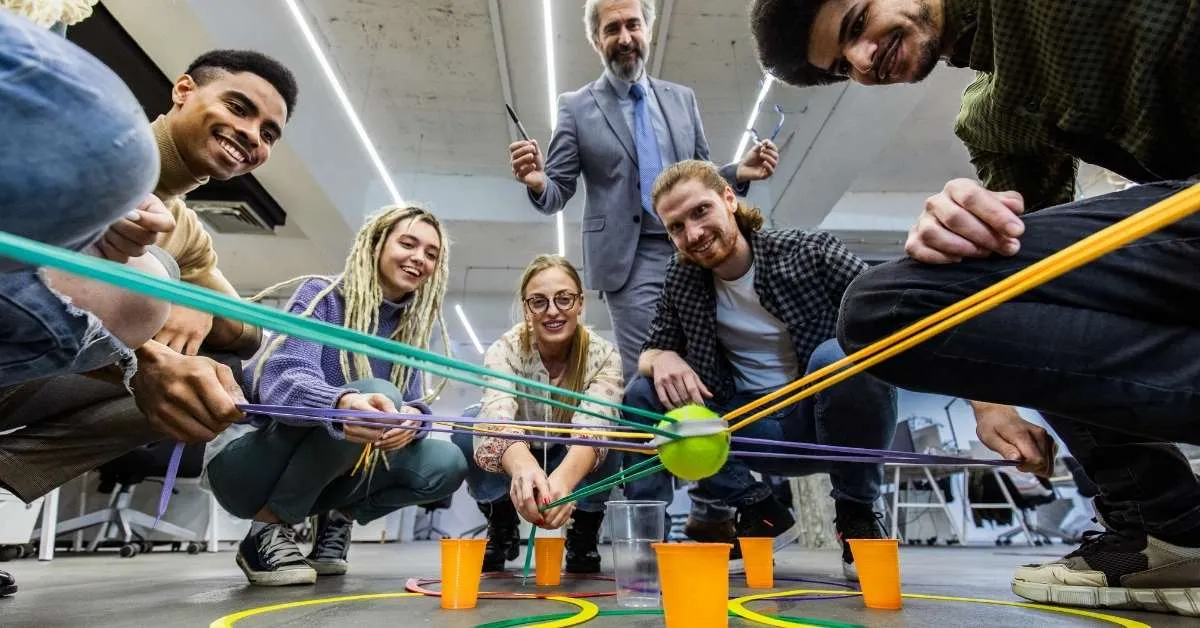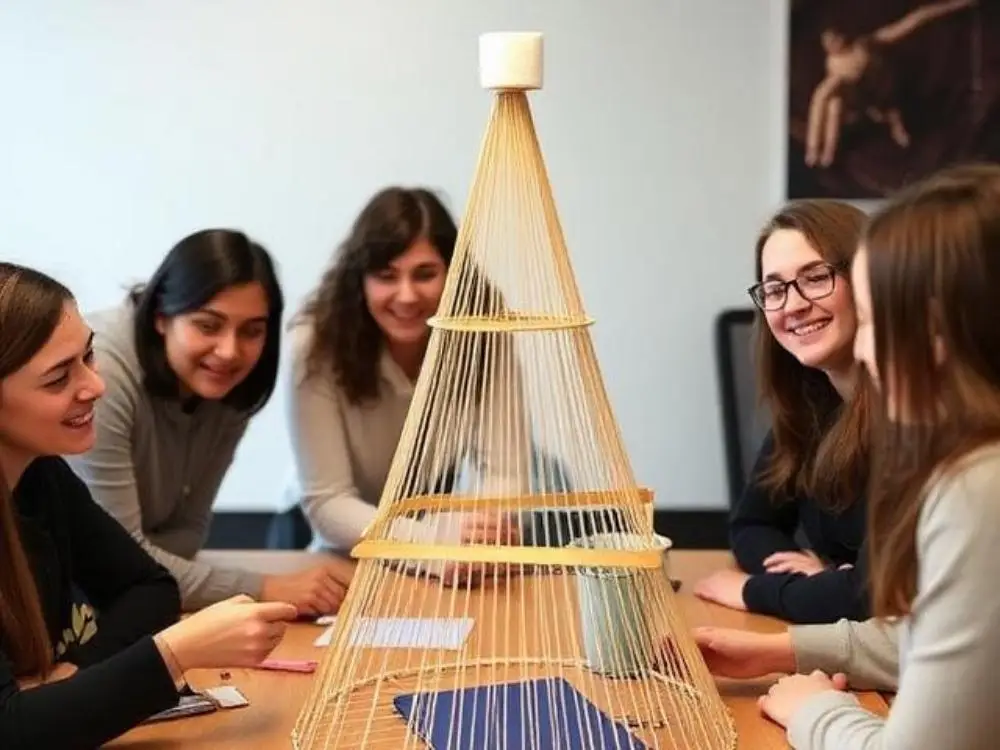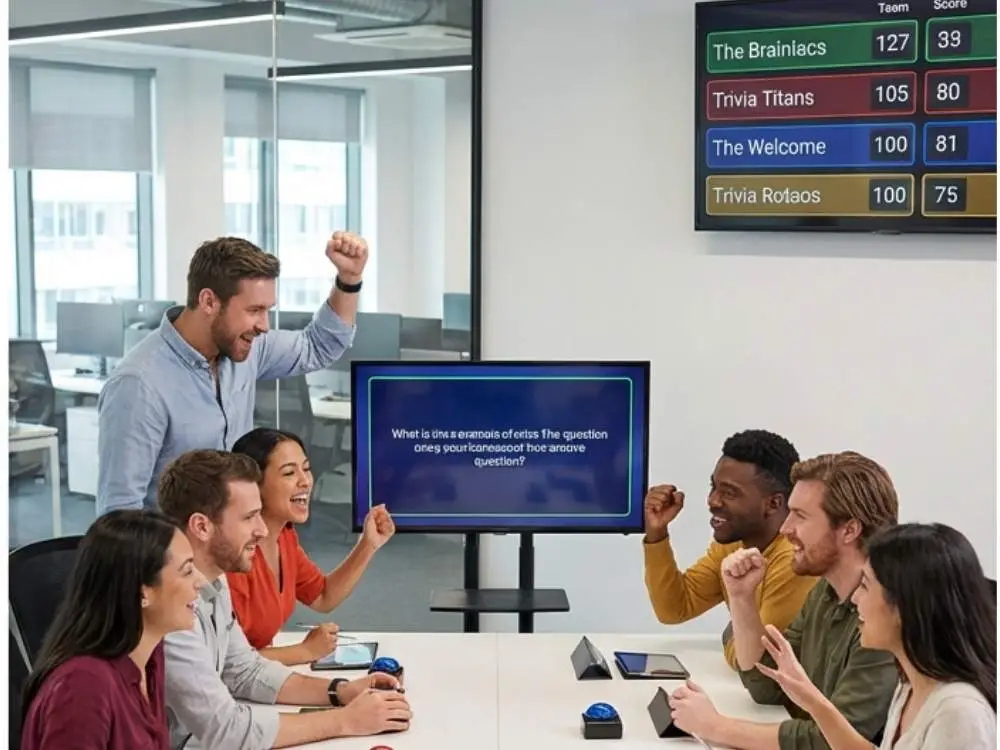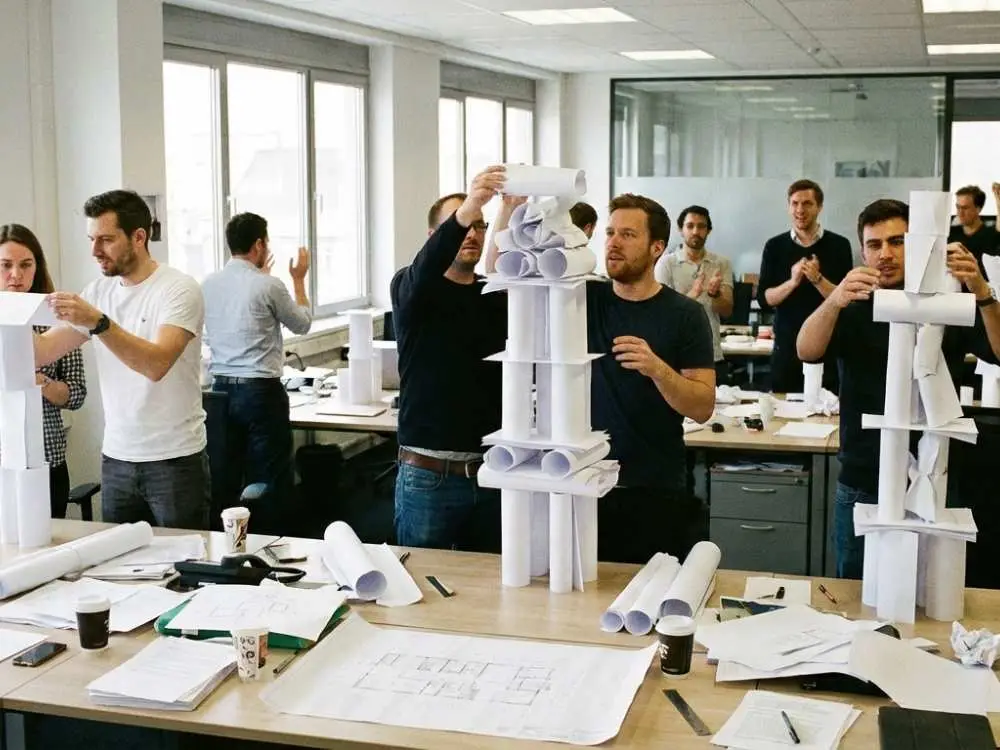
15 Best Indoor Team Building Games to Strengthen Your Team
When was the last time your team had genuine fun together at work? Building strong workplace relationships shouldn't be a struggle. But many teams are unable to connect beyond simple emails and meetings. Initially, I thought indoor team building games felt forced or awkward.
Then I tried a few, and suddenly people talked, laughed, and acted like an actual team instead of coworkers trapped in shared Wi-Fi. If you want to strengthen your crew without stepping outside or breaking anyone’s spirit, these 15 indoor team building games work like a charm.
Key Takeaways
- Explore the 15 best indoor team building games that improve team connection.
- Know how to pick the right indoor team building game for your requirements.
- Benefits of indoor games and tips to make them actually effective.
1. Human Bingo
Human Bingo is a fantastic game to energize a quiet room. You hand everyone a bingo card filled with quirky facts. Once they get a card, they race to find people who match each square.

Why it works:
- Moves everyone and gets them talking instead of looking at their phones.
- Breaks those awkward silences when people barely know each other.
- Reveals surprising connections, like finding out your quiet coworker once lived in Japan.
- Works perfectly for new hires or teams that feel disconnected.
Ever realize someone on your team loves the same weird podcast as you? That's when real conversations start. Human Bingo turns strangers into actual people with stories worth hearing.
2. The Marshmallow Challenge
You split people into teams and ask them to build the tallest free-standing structure. The teams use spaghetti, tape, string, and one marshmallow. The marshmallow must sit on top. This game is chaotic but hilarious.

Benefits:
- Make people collaborate instead of working solo like they usually do.
- Tests creative problem-solving under pressure.
- Shows who naturally leads and who supports the team.
- Teaches that failing fast and adjusting beats overthinking every move.
I tried this once for my team and watched a perfectly good structure collapse in dramatic slow-motion seconds before time ran out. Everyone groaned, then laughed until they cried. That shared failure somehow brought the team closer than any success could have.
3. Office Trivia Showdown
You test the team's knowledge about the company's mission, history, projects, or even random office moments. Trivia always triggers friendly competition and gets people surprisingly invested.

Make it fun with:
- Surprise lightning rounds that keep the energy high and prevent overthinking.
- Funny team names that people actually remember months later.
- Rewards for winners like coffee gift cards or leaving early on Friday.
- Mix of easy and tough questions so everyone contributes something.
Ever notice how people suddenly remember every tiny detail when snacks are on the line? Someone will recall the exact date the office moved or that weird motivational poster from three years ago. Trivia turns your workplace into shared history worth celebrating.
4. Blindfold Building
Pair up teammates, blindfold one person, and let the other guide them to build something with blocks or simple craft pieces. This game becomes a real test of communication and patience.

Why it strengthens teams:
- Builds trust without any shortcuts.
- Reveals how clearly someone actually explains things under pressure.
- Teaches active listening when you can't rely on gestures or pointing.
- Shows that assumptions affect progress faster than anything else.
You learn a lot about someone when they try to explain which block is "kind of square but also not really." Watching your coworker struggle to describe "the blue one, no the other blue one" is funny. But afterward, people communicate better because they realize words actually matter.
5. Paper Tower Competition
You give each group a stack of paper and a timer. The mission is to build the tallest tower possible. No tape or glue allowed. Just pure structural chaos and questionable physics.

Why it works:
- Encourages problem-solving when resources are deliberately limited.
- Promotes teamwork instead of just one person taking over.
- Builds friendly rivalry that actually motivates instead of dividing people.
- Reveals who thinks outside the box and who panics under time pressure.
FYI, even the most serious people transform into competitive engineers within minutes. That guy from accounting who never speaks up? Suddenly, he's folding paper into advanced geometric shapes and barking instructions. Watching normally reserved coworkers defend their wobbly towers with genuine passion never gets old.
6. Team Charades
Charades never disappoints. You split into teams, pick categories, and prepare for dramatic reenactments mixed with questionable acting skills that nobody will let anyone forget.

Best categories:
- Movies or TV shows everyone pretends they've watched.
- Professions that get wildly exaggerated within seconds.
- Random office situations like "Monday morning before coffee".
- Inside work memes or company moments only your team understands.
Ever watch your quietest teammate overact a superhero scene with zero self-consciousness? That's when you know the game works. People drop their professional guard and just be goofy humans. The person who never talks in meetings suddenly becomes the star performer, and everyone sees them differently after that.
7. Puzzle Race
Each group gets the same puzzle. First team to finish wins. Simple, competitive, and surprisingly intense once that timer starts ticking.

Why I like it:
- Encourages natural collaboration since nobody can dominate the entire puzzle alone.
- Reveals who spots patterns quickly and who gets lost in details.
- Keeps everyone focused because there's visible progress.
- Shows how teams handle stress when they fall behind.
Teams always panic when they realize they misplaced one piece, and suddenly everyone's on their hands and knees searching the floor. The accusations fly and strategies shift, where someone always tries to reorganize the whole approach midway through.
8. The Communication Lineup
You ask your team to line up by birthday, height, years at the company, or any other factor without talking. They must use gestures only. No whispering, no mouthing words, just pure charades.

Strengthens:
- Nonverbal communication skills people forget they actually need daily.
- Creative problem solving when the obvious solution disappears.
- Patience with teammates who communicate differently than you do.
- Team awareness as people notice details about each other that they missed before.
People get creative fast when they can't rely on words. Someone always becomes the unofficial coordinator through exaggerated hand signals. Others start drawing numbers in the air or acting out entire scenarios.
Watching your team figure out birth months through finger counting and confused facial expressions is pure entertainment, and it genuinely improves how they read each other later.
9. Balloon Keep Up
This awesome indoor team building game is about giving each team a few balloons, and they need to keep those balloons in the air longer than any other group. It looks silly but it builds teamwork instantly.

Why it works:
- Demands quick coordination without time to overthink or assign roles.
- Energizes the entire room as people jump around and dive for balloons.
- Forces constant awareness of what teammates are doing and where they're moving.
- Breaks down barriers because everyone looks equally ridiculous together.
The quiet person becomes the team MVP. Someone discovers their coworker has shockingly good reflexes. And watching everyone rush the same balloon while another drops behind them? Perfect metaphor for bad workplace communication, except way funnier.
10. Indoor Scavenger Hunt
You create a list of items or clues hidden around the office. Teams race to find everything first. Simple concept, but the competitive energy turns your workspace into an adventure zone.

Pro tips:
- Include tricky clues that require actual thinking, not just wandering around.
- Add bonus challenges like taking team photos in weird locations.
- Set a strict time limit so urgency keeps everyone moving.
- Mix obvious items with obscure ones that only longtime employees might know.
Ever watch grown adults sprint down hallways for a stapler like their lives depend on it? funny right? People rediscover parts of the office they forgot existed. That storage closet nobody opens? Suddenly, it's prime real estate. The hunt breaks routine, gets people moving, which creates inside jokes that last for months.
11. Pass the Story
You start a story with one sentence. Each person adds a new line until the tale spirals into complete absurdity. No planning allowed, just pure improvisation and chaos.

Why teams love it:
- Unleashes creativity people didn't know they had hiding behind spreadsheets.
- Requires active listening since you can't add anything without tracking the plot.
- Creates shared humor that becomes part of team culture for weeks.
- Shows different thinking styles, as some people go logical and others go wild.
I once saw a story shift from a normal workday to a dramatic alien invasion in ten sentences. Someone added a talking cat. Then time travel appeared. By the end, nobody remembered the original point, but everyone was crying from laughter. Those bizarre stories stick with teams way longer than any serious exercise ever could.
12. Build and Pitch
You give teams random objects like pipe cleaners, markers, cardboard, and straws. Their mission is to build a product prototype and pitch it like a startup.

Develops:
- Innovation under constraints when perfection isn't an option.
- Presentation skills, as people practice selling ridiculous ideas with straight faces.
- Collaboration between innovative thinkers and practical planners on the team.
- Confidence in sharing half-baked ideas without fear of judgment.
Ever watch a team pitch an invisible pet robot with genuine conviction? Surprisingly convincing. The marketing person creates a slogan. The analytical one explains revenue. Someone designs packaging from napkins. These silly pitches teach real collaboration skills without the pressure of actual consequences.
13. The Yes Game
You challenge everyone to say yes to every suggestion given by teammates during a short improv round. It keeps energy positive and encourages openness instead of the usual workplace skepticism.

Benefits:
- Promotes acceptance of ideas without immediate criticism or doubt.
- Enhances quick thinking since you can't stall by overthinking responses.
- Improves team morale by creating a judgment-free zone for wild ideas.
- Breaks the habit of shooting down suggestions before they fully develop.
People bond fast when creativity replaces hesitation. The person who always says "but that won't work" suddenly has to build on crazy ideas instead.
14. Memory Tray Challenge
You place several objects on a tray, show it for ten seconds, then cover it. Teams write down everything they remember. Simple premise, surprisingly humbling results.

Why it strengthens teams:
- Builds attention to detail that people assume they already have.
- Shows how different team members notice completely different things.
- Encourages collaboration as people pool their observations together.
- Creates friendly rivalry without high stakes or hurt feelings.
Ever think you're observant then forget half the objects? Same. Someone remembers the paperclip but misses the entire coffee mug. Another swears there was a pen that never existed. Teams quickly learn they're stronger combining perspectives than trusting one memory. The arguments about what was actually there get genuinely heated and hilarious.
15. Problem Solving Mystery Bags
You fill bags with random items like spoons, string, tape, paperclips, or any other items. Each team gets a bag and a challenge to solve with only the objects inside.

Possible challenges:
- Build a bridge for a small object.
- Create a tool that moves something.
- Construct a mini catapult.
- Design a container that protects an egg from a short drop.
These games reveal who thinks on their feet and who panics at the sight of a paperclip. Watching teams create solutions from junk teaches real lessons about resourcefulness.
How to Pick the Right Indoor Team Building Game
Choosing the right game actually matters more than you think. Ever try a quiet reflective activity with a high-energy group? Complete disaster. Always match the activity to your team’s vibe.
Consider:
- Group size because some games fall apart with too many or too few people.
- Time available since rushing through a game damages the fun entirely.
- Physical limitations so nobody feels excluded or uncomfortable participating.
- Desired outcome like building trust versus just breaking the ice quickly.
- Team mood because forcing enthusiasm on a tired Friday afternoon never works.
I usually ask a quick question or two before starting. People appreciate having choices instead of feeling ambushed by mandatory fun.
Tips to Make Indoor Team Building Games Actually Effective
Games alone won’t magically turn your team into office superheroes. The execution makes the difference.
Try these tips:
- Keep instructions simple.
- Maintain a fun, light tone.
- Rotate leadership roles.
- Allow people to opt in or out.
- Debrief afterward to share takeaways.
- Celebrate small wins.
Ever notice how much people enjoy activities when no one pressures them? The same rule applies here.
How Indoor Games Strengthen Teams
Indoor team building games strengthen teams because they create shared experiences outside the usual work stress. People open up. They communicate more naturally. They trust each other beyond email threads and project deadlines.
Games help teams:
- Reduce tension by permitting people to laugh together.
- Improve collaboration through low-stakes practice before real pressure hits.
- Encourage creativity when the usual workplace rules temporarily disappear.
- Build camaraderie that carries over into actual work situations later.
- Boost morale by reminding people that their coworkers are actual humans worth knowing.
Strong teams don’t magically happen. They grow when people connect through small but meaningful moments. These games create memories that transform strangers into teammates who actually care about each other's success.
Wrapping Up
Indoor team building games work well because they're memorable and actually fun. You don't need fancy equipment or a massive budget. Just pick a game, gather your team, and watch what happens. The laughter and connections you build today make every future project easier. Your team deserves that investment.
FAQs
Q1: What if my team hates team building activities?
Initiate with a quick and no-pressure activity. Participation shouldn't be forced. Let reluctant people observe first. Generally, the skeptics will join in after they witness others having fun. The key is to keep it light and optional during the start.
Q2: How long should indoor team building games last?
Between 15 to 30 minutes per game works best. Shorter feels rushed and longer ones make people lose interest. If you prefer doing multiple games, plan around 90 minutes total. Always stop while energy is still high, not when everyone's exhausted.
Explore Related Posts
https://smarttoolsai.com/post/virtual-team-building-activities
.webp)